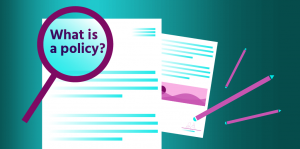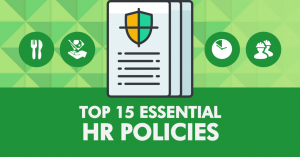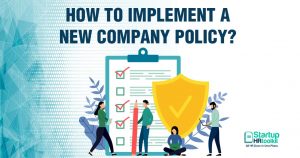22 Writing a New Policy
Learning Objectives
- Importance of writing the policies in an Organization.
- Steps that are involved in the whole process of writing a new policy.
- Implementation of the new policy in an effective way.
Introduction
A policy is a document of instructions that define how things are to be performed in an organization and is usually approved officially by management.(Enaohwo, 2020)
(Enaohwo, 2020)Info graphic
The importance of writing HR policies
The following points indicate us why are HR policies important for human resource management:
- Reflect the culture and expectations for your organization.(SpriggHR.2020)
- Protect employees from wrong behavior.(SpriggHR.2020)
- Ensure every employee receives appropriate compensation and the same treatment.(SpriggHR.2020)
- Assist management to make right decisions which are following legislation.(SpriggHR.2020)
- Assist to maintain discipline in the workplace and implement best practices right to your (SpriggHR.2020)
1.Recruitment and Employment
It is crucial to attract talented and qualified employees to develop and maintain the success of your company. (Ferguson, 2021). Recruitment policies explain what goes into recruitment and selection processes and what are company’s expectations when it comes to hiring and employing new people (Ferguson, 2021). Company should be pay attention to make a clear, professional, and attractive recruiting policies.
2.Training and Development
It is duty of the organization to develop employee skills, knowledge, and abilities. A training plan should be updated based on the current and future of the organization every year(Ferguson, 2021). If the employees do not find any development opportunities in the company, they probably will leave their jobs.
Training policies explain about the resources that are available for the training and professional development of the employees. The older as well as the new employees get assurance for assistance through the policies. (Ferguson, 2021)
3.Compensation and Evaluations
Compensation and evaluations policies indicates about the evaluation and management of employee performance(Ferguson, 2021). It shows how the employees will be compensated and rewarded according to their efforts and responsibilities. In addition, it describes the details of the compensation components which pertain to specific situation(Ferguson, 2021).
4.Employee Issues
HR Policies guides the employees about how to handle and solve problems at work. It is important every HR department creates and implements policies to support consistent treatment of employees, fairness, and transparency(Enaohwo, 2020). Also, policies serve as a guide dealing with employee issues and claims.(Ferguson, 2021)
5.Company Rules
HR Policies state the code of ethics and internal policies of an organization. This includes leaves, time attendance, holidays, safety, discrimination, and regulations of employee conduct etc.(Ferguson, 2021)
Ethics vary from person to person and from organization to organization, so by outlining them employees get to know about what is accepted as a good behavior in their company. (Ferguson, 2021)
6.Disciplinary and Termination
Disciplinary and termination policies state the reasons for which an employee can be fired. It is stated very clearly in the policies how an employee can be terminated if he does not comply to the laws of an organization. (Ferguson, 2021)
HR Policies in each HR areas
Here is the list of HR policies typically found in each HR areas that an organization needs to (Gibbons, 2021):
- Recruitment and Selection

- Employee Conduct
- Harassment & Discrimination
- Sexual Harassment
- Conflict of Interest
- Confidentiality and Non-Disclosure
- Privacy
- Dress Code
SpriggHR.(2020).Info graphic
- Leave and Attendance
- Time and Attendance
- Vacation policy
- Family leave
- Parental leave
- Bereavement leave
- Sick leave
- Personal leave of Absence
- Unpaid leave
- Jury Duty and Voting
- Short Term Disability, Long Term Disability
- Statutory Holidays
- Health, Safety and Security
- Occupational Health & Safety Policy (OHS)
- Workplace Violence
- Drugs and Alcohol policy
- Smoking policy
- COVID-10 policy
- Compensation and benefits
- Employ classifications
- Benefits and Eligibility
- Workdays, paydays, and pay advances.
- Overtime compensation
- Payroll deductions
- Performance Management
- At-Wil Employment
- Performance evaluations and salary increases
- Performance improvement
- Termination
- Disciplinary Action
- Work Travel
- Use of Technology
Guidelines for writing a new policy
(GreggU, 2018)Youtube video
Below are the necessary guidelines you need to make your preparations for writing your policy fruitful.(Enaohwo, 2020)
- Make a priority list and determine writing style
It is crucial to make a priority list because you cannot work on multiple policies at one time. You can make a list of new policies to be included and reviewed(Enaohwo, 2020). The policy that will reward you with quick success should be at the top of your list. You could have a meeting with your team members to determine which of the policies need to be attended to immediately(Enaohwo, 2020). With this, you know exactly where to begin. (Enaohwo, 2020)
Your writing style also determines whether your policy can be easily understood. Determine your writing style first by the following tips. (Enaohwo, 2020):
- Written in a concise and plain language.(Enaohwo, 2020)
- Keep it as a well-defined procedure.(Enaohwo, 2020)
- Easy to understand and avoid outdated information.(Enaohwo, 2020)
- Consider the benefits and fairness of the employees.
- Show appropriate exceptions.(How to write clear and effective HR policies for your organisation – Not-For-Profit People. Not-For-Profit People. (2018)
- Research

It is very important to going on a research before writing a policy to have an in-depth knowledge of the organization(Enaohwo, 2020). When you reconsider a policy that appears obsolete, a proper examination should be conducted to determine the limitations of the current policy and find out the best way for the future policies(Enaohwo, 2020). Research can be conducted through interviews with employees, consulting the experts and identify the laws that are related to your policies. Take the help of an expert to make the first draft. (Enaohwo, 2020)
SpriggHR.(2020).Info graphic
- Review
Once the research is conducted, the next step is to review your work. No one gets it right for the first time(Enaohwo, 2020). The work needs to be reviewed. For some policies you may want to take the help of an expert or a non-expert to do proofreading and find out the mistakes and ways to write a good policy(Enaohwo, 2020).
It is good practice to ask persons to review your work. Here are some ways of review to be considered below.
Manager review
- Perform and monitor the policy in detail. (HR policies.2021)
- Understand different parties’ responsibilities. (HR policies.2021)
- Ensure there is no wording unbiased.HR policies.(HR policies.2021)
Employee review
- Understand responsibilities.(HR policies.2021)
- Understand organization’s expectations.(HR policies.2021)
- Review fairness, and transparency.(HR policies.2021)
Expert or Legal review
- Apply to complex policies not for all policies.(HR policies.2021)
- Review and check the policies which are complies with legislation and government regulations.(HR policies.2021)
- Ensure to deal with employee issues and claims legally.(HR policies.2021)
4. Get approval
The final step in the writing stage is to get the approval to finalize your policy. The approval might be from:
- An executive member holding a top position in the management
- Board
When provide the executive member or the board with information on why the policy is needed and the steps you took in developing the content for the policy(HR policies.2021). You should schedule review date to consult with the approval person. After you have the approval, add the date of approval to the policy.(Enaohwo, 2020)
Before writing a policy, it is necessary to do some prewriting. (Enaohwo, 2020)Now you have everything for the prewriting stage, the next step is to pay attention to the do’s and don’ts of policy writing, follow the prewriting tips, and the next steps will follow easily(Enaohwo, 2020). As you are done with the prewriting stage, now it is time to write a new policy. (Enaohwo, 2020)
Before you begin writing a new policy
Following things should be kept in mind before beginning to write a policy:
- Consider everyone’s consent to write a policy
It is very important to have the full support of the management and the staff before you start creating a policy. Tell them about the reasons for creating a policy and why the organization requires it to be drafted soon. (Enaohwo, 2020)
(Enaohwo, 2020)Info graphic
- Forming a team
It is not easy to write a policy overnight and individually. You need a team to help you go through the process of developing a policy. You need the consultations of the experts in your team who not only know how to write a policy but should also be competent in focusing on the proposed topic for the policy. (Enaohwo, 2020)
3. Policy structure should be standard
If your aim is to write a policy document that is organized, effortlessly understandable, and easy to navigate, then you need a standardized policy structure. (Enaohwo, 2020)
- Download software that will help simplify the process
It is effectively to use software programs to create HR policies. With the help of these software programs, the process of policy making becomes much easier. With the right programming set up, you can access your records easily. Furthermore, obviously, you and your colleagues can cooperate in any event, when you are not in a similar spot. While you are taking care of these various things, there are rules you need to follow to guarantee that the prewriting cycle is simple and smooth. The accompanying rules should ease you forward. (Enaohwo, 2020)
Writing a new policy
Once the pre-writing steps are completed, there is a need to consider the elements that are necessary for writing a new policies which are as follows: format, design, writing style, and key elements (Enaohwo, 2020).
(Enaohwo, 2020) – Info graphic for writing a new policy.
Format of a policy document
The formatting style of the policy is crucial as it helps in understanding of the document easily (Enaohwo, 2020). The formatting guidelines as explained below will help us in creating an effective and clear policy documents (Enaohwo, 2020).
1. Using professional font and font styles
As this is an official document, it is necessary to use professional font styles for writing (Enaohwo, 2020). Generally, the recommended ones are – “Arial, Calibri, Cambria, Garamond, Times New Roman or Georgia” (Enaohwo, 2020).
2. Consistent font size
It is important to maintain a consistent font size for the whole document except for headings and subheadings (Enaohwo, 2020). The recommended font size for headings and text is 14 and 12 respectively (Enaohwo, 2020). The policy styles can be saved as a template for future use in word document (Enaohwo, 2020).
3. Being inclusive
The policies implies for everyone equally (Info-Tech research group, 2016). Therefore, it is necessary to use pronouns such as “they and their” (Info-Tech research group, 2016).
4. Avoid colors
Try and avoid color as much as possible as they create an unprofessional experience (Enaohwo, 2020). However, to illustrate examples they can be used in a small amount (Enaohwo, 2020).
5. Be specific
To avoid misconception it is necessary to define key terms and write the document in a manner that addresses the issues (Info-Tech research group, 2016).
6. Appropriate spacing
There must be proper spacing between the paragraphs, sections, and subsections” (Enaohwo, 2020). This helps readers to grasp the key information easily (Enaohwo, 2020).
After the formatting is done, the next step is to design the policy document
Design and layout of a policy document
The policy requires to have a reader-friendly design and layout. A few tips that will help us achieve that are listed below:
- It is critical to use a lot of white spaces (Enaohwo, 2020).
- The structure must be designed in such a way that the employees can easily find what’s significant for them (Enaohwo, 2020).
- Usage of labels to effectively demonstrate important topics (Enaohwo, 2020).
- Creating the policy with an outline will make it easy to make corrections in the future (Enaohwo, 2020).
Here is a sample template of the policy document (ConvergePoint, 2021).
| INSERT COMPANY LOGO | Policy Procedure Manual |
|
Document Number: |
Enter Policy Number. |
| Document Name: | Enter Policy Name |
| Effective Date: | Select effective date. |
| Document Status: |
1.0 Purpose
Click here to enter text.
2.0 Policy Details
Click here to enter text.
3.0 Policy Scope
Click here to enter text.
4.0 Related Policies
Click here to enter text.
5.0 Policy Owner
Click here to enter text.
| Last Modified By: | Enter Text | Last Modified On: | Select Date | Page: | 1 |
| Document Owner: | Enter Text | Original Date: | Select Date |
Template Courtesy: ConvergePoint (www.convergepoint.com)
Key elements of a standard policy
Your policy document should include:
1. Header: It contains the name of the organization and why that particular policy is being created (Enaohwo, 2020).
2. Dates: There should be a date written there about when the policy was initially made operative (Enaohwo, 2020). If it is being reviewed, the date of review should be indicated (Enaohwo, 2020).
Here is an example:
“XYZ Company’s attendance policy went into effect on Jan.1, 1989. It was revised on
Jan. 1, 1999 and again on Jan. 1, 2010” (Enaohwo, 2020).
3. Title: It should reflect the total content of the policy (Enaohwo, 2020).
4. Authority’s approval: This consists of the name of the individual who approved the development of the policy (Enaohwo, 2020).
5. Policy statement: This is where you state the purpose of creating the policy (Enaohwo, 2020). The questions such as “who, why, what, when, and where of the policy” are addressed here (Enaohwo, 2020).
6. Scope of the policy: This is implied to a section/group of people the policy would apply to (Enaohwo, 2020).
7. Procedure number: It is used for referencing (Enaohwo, 2020). “Ensure that spaces between the numbers are equal and that they are written in numerical figures” (Enaohwo, 2020).
8. Procedure: It lays out the detailed processes that must be followed to ensure that the policies are obeyed in the organization (Enaohwo, 2020).
9. Different parties and responsibilities: The various components that must be included to implement the policy (Enaohwo, 2020).
10. Directive: This section is for important instructions (Enaohwo, 2020).
11. Page numbering: Each page should have an appropriate page number (Enaohwo, 2020).
12. Definitions: There should be clear definitions for the words that are not commonly used (Enaohwo, 2020).
13. References: If the policy is developed from other sources then it must be referenced (Enaohwo, 2020).
Include all these elements in the policy document and we will have a complete policy. Now let us look at creating a new policy (Enaohwo, 2020).
Write, edit, rewrite
Writing a policy is a tedious process (Enaohwo, 2020). Before we begin writing, we need to carry out a lot of research and analyze it (Enaohwo, 2020). Once done, there is a need to re-write as the first draft is never good to go, even though we have a complete understanding on how to write (Enaohwo, 2020). We need to research with the colleagues, make a draft, check with them, consult an expert and work on it until there are no errors (Enaohwo, 2020). We must revise multiple times before finalizing it (Enaohwo, 2020).
IMPLEMENTING THE NEW POLICY
Companies make sure that the policies are fair for everyone (SHRM, 2021). They mainly highlight the acceptable and unacceptable behaviors (SHRM, 2021). It also helps the employees to understand what they must do in the workplace (SHRM, 2021). The major processes involved to implement the policies are:
(Enaohwo, 2020) – Info graphic for implementing a new policy.
1. Identify the need for the policy
Clear foundations must be laid out as to what the policy will bring in to the company (SHRM, 2021). For instance, policies may be developed because of legal protection, government laws, creating standards within the organization, and other government regulations (SHRM, 2021).
2. Distributing your policy
The first thing that needs to be done after approval is to distribute the policy to all the staff members in the organization (Enaohwo, 2020). It can be done by sending the link of the document to every employee through mail (Enaohwo, 2020). It can also be printed and distributed as a hard copy (Enaohwo, 2020).
3. Training
The employees in an organization might not know how to effectively carry out the instructions written in the policy even though they comply with the instructions (Enaohwo, 2020). They need to be trained so that they can understand the instructions and procedures to avoid mistakes (Enaohwo, 2020). Videos and case studies can be the best guides (Enaohwo, 2020). Such trainings should ensure that employees can freely express themselves, ask questions, and make suggestions (Enaohwo, 2020).
4. Obtain stakeholder support
It is crucial to gain support from the stakeholders (SHRM, 2021). Hold meetings via online or offline and put forward the changes that would be taking place in the organization (SHRM, 2021). Address the impacts these policies will have on the company (SHRM, 2021).
5. Regular policy reviews
The policy should be reviewed regularly to ensure that the procedures in the policy are not outdated or lose relevance in the new environment (Enaohwo, 2020). This is because the laws as well as professional practices keep changing (Enaohwo, 2020). Also, sometimes minor changes are implemented in the policy and it is not completely rewritten (Enaohwo, 2020).
Effectively ensuring policy compliance comes after approving the policy and training the employees.
Policy compliance management

(Enaohwo, 2020) – Making the changes in policy
In order to confirm policy compliance we must follow these:
- Create policies that cover each and every detail of the organization’s work procedures that we want to effectively manage (Enaohwo, 2020).
- Train and teach the employees about the policies in such a way that they become aware of its rules and the risks involved (Enaohwo, 2020).
- Create a team to implement the policy effectively (Enaohwo, 2020).
- Get software that helps to implement and manage the policy (Enaohwo, 2020).
The policy compliances are easier if policy legalities are properly addressed.
Policy legalities
When writing your policy, you have to make sure it is legally binding. How?
- Make sure your policy is in line with legal rules
The policy should not only be officially right, but this should be additionally lawful. It ought not mock any laws of the state or country. Before writing a new policy, it is very important to set out to find out about laws related to organizations in your region and ensure your policy doesn’t conflict with any of these laws. It is fitting that you get the organization’s legal advisor to go through the policy before it is endorsed and made operative. Your legal counselor ought to be there when you direct surveys. (Enaohwo, 2020)
- Your policy manual should include policies against discrimination
There are different anti-discrimination policies set up by the government and it is the duty of your organization to abide by them. Make sure that your policy manual accommodates these policies. You and your employees are supposed to abide by these policies. (Enaohwo, 2020)
- Ensure your employees sign your policy
Once your policy is distributed, employees are to officially agree to its implementation by signing the policy. This should also be done for new employees or whenever changes are made to the policy. This action holds them responsible for the policy if they or the management ever decide to take up any legal action. Implementing policies is obviously more important than the actual writing process. With a well-implemented policy, your organization is bound to run smoothly and efficiently. The essence of writing any policy is so that it can be implemented. (Enaohwo, 2020)
When you are done with every formality regarding writing the policies, you are successful as a policy maker.
For further references, here is a link on a number of policies, retrieved from WorksafeBC:
https://www.worksafebc.com/en/search#sort=Relevancy&q=policy&f:language-facet=[English]
Key Takeaways
- HR Policy is a document of instructions that states how the things are to be carried out in an Organization.
- It is very important for an Organization to develop new policies when needed.
- Policies should be created in a step by step manner to make them look effective. Each step should be consider as important when writing a new policy.
- Learning how to write a policy is one thing; actually writing it is another – implementing is yet another important thing about the policy.
References
Enaohwo, O. M. (2020, 01 28). Guidelines for writing a new policy. Retrieved from https://www.sweetprocess.com/how-to-write-a-policy/.
SpriggHR.(2020,03 16). 15 Essential HR Policies. https://sprigghr.com/blog/hr-professionals/15-essential-hr-policies/
Ferguson, G. (2021). What Are the Benefits of HR Policies?. Small Business – Chron.com. Retrieved 18 June 2021, fromhttps://smallbusiness.chron.com/benefits-hr-policies-41543.html.
GreggU. (2018). HR Basics: Human Resource Policy [Video]. YouTube.https://www.youtube.com/watch?v=fWsLBFN5-mg
Gibbons, M. (2021). What Are HR Policies? + 7 Main Types To Have In Place. People Managing People. Retrieved 16 June 2021, from
Susan M. Heathfield(2021, 01 16). Sample Human Resources Policies and Procedures.https://www.thebalancecareers.com/sample-human2021, -resources-policies-and-procedures-1918876
BC government. (2021).Statutory Holidays.https://www2.gov.bc.ca/gov/content/employment-business/employment-standards-advice/employment-standards/statutory-holidays
WorksafeBC.(2021).Health & Safety Policies.https://www.worksafebc.com/en/law-policy/occupational-health-safety/ohs-policies
SHRM(2021)Policies.https://www.shrm.org/ResourcesAndTools/tools-and-samples/policies/Pages/default.aspx
HR policies.(2021)https://www.ndirf.com/image/cache/Handouts-HR_Policies_Guidelines.pdf
How to write clear and effective HR policies for your organisation – Not-For-Profit People. Not-For-Profit People. (2018). Retrieved 18 June 2021, from
https://nfppeople.com.au/2018/01/how-to-write-clear-and-effective-hr-policies-for-your-organisation/.
ConvergePoint. (2021). Sample template of policy. Retrieved from https://www.convergepoint.com/policy-management-software/.
Info-Tech research group. (2016). Writing effective policies. Retrieved from file:///C:/Users/Sukumar/Desktop/seminar%20stuff/myPolicies___how_to_write_an_effective_policy%20(1).pdf.
SHRM. (2021). Developing and implementing a new policy. Retrieved from https://www.shrm.org/resourcesandtools/tools-and-samples/how-to-guides/pages/howtodevelopandimplementanewcompanypolicy.aspx.
